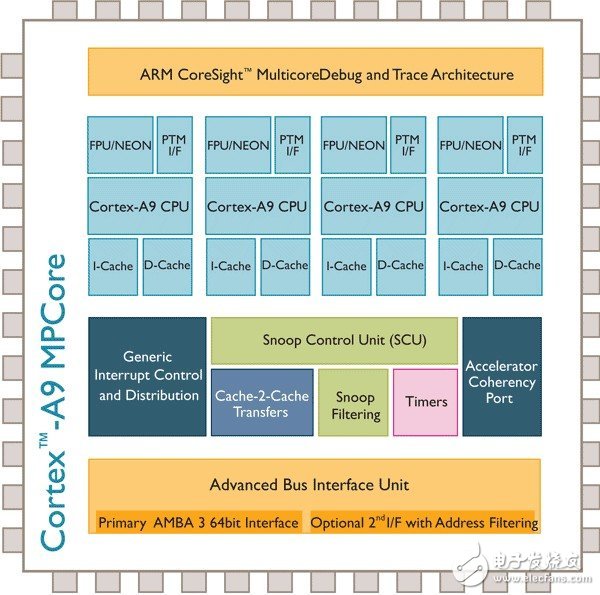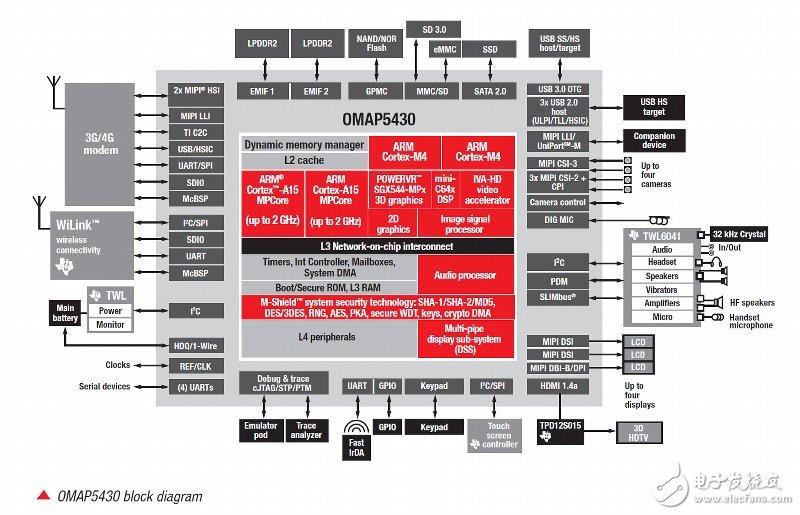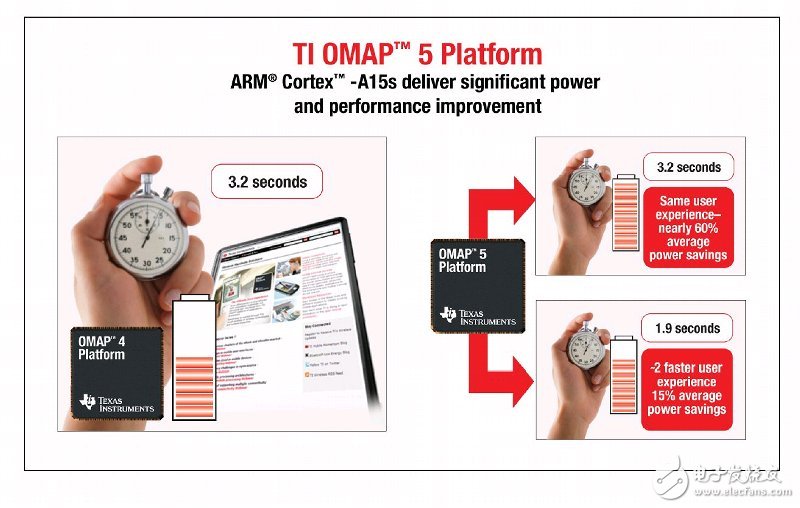ARM Cortex A15 core
At present, smartphones have moved closer to the four cores, but they are also quad-cores, and the performance of mobile phones is very different. In addition to the four-core Qualcomm Krait series architecture that emerged last year, the ARM family Cortex A15 is also officially on the quad-core history stage. For example, Samsung's Exynos 5 Octa and NVIDIA's Tegra 4 use the Cortex A15 architecture. At the same time, the processor of the smart mobile device iPad3 is rumored to use the new ARM Cortex A15 architecture processor. Although the Apple iPad3 processor is more A5X or A6, the Cortex-A15 architecture is very likely. We can get a comprehensive level of understanding of the Cortex A15 architecture from TI, Samsung and Qualcomm products.

ARM Cortex-A15 architecture diagram
The Cortex-A15 core, like the Cortex-A9, is also based on the ARMv7-A architecture and is a replacement for the Cortex-A9, but the architecture has changed significantly, which is important for multi-core efficiency and management. On the floating point unit, there are also upgrades. Let's take a look at the changes in the Cortex-A15.

ARM Cortex-A9 architecture diagram

ARM Cortex-A9 workflow diagram
First, we see the schematic diagram of the two processors officially provided by ARM. We found that in the Cortex-A9 processor workflow, multi-core interrupt control and allocation is placed on the last layer, while in the Cortex-A15, this part of the work is placed before the core operations. In NVIDIA's Tegra3 technical documentation, it was mentioned that under Android, when multiple cores run at different frequencies on different cores, the overall efficiency will be limited by the core of the lowest frequency, so Tegra3 is optimized in multi-core control management. Perhaps this is related to the ARM Cortex-A9 multi-core original design. On the Cortex-A15, the architecture has changed a lot, and many core processes are more efficient.
From the point of view of the floating-point unit, the Cortex-A15 core has a built-in VFPv4 floating point unit for each core. VFPv4 is Vector FloaTIng-Point version 4, while on Cortex-A9 is Version 3 and Cortex-A8 is Version 2. This VFPv4 is the floating point operation of the ARM processor for the first time fully supports the IEEE 754 standard. In the past, the floating-point performance of ARM processors has been a short-term, especially before ARMv7, how does VFPv4 improve floating-point operations?
In addition, the Cortex-A15's cache management has been slightly improved. Each core will have 32KB of data and instruction L1 Cache respectively. The L2 Cache L2 cache is shared by multiple cores. Currently, the official data is supported by 512KB, 1MB, 2MB, 4MB, etc. The control mechanism of L2 cache is delayed. The Cortex-A9 has improved.
Finally, the Cortex-A15 was designed from the ground up not only for mobile devices, it supports 40bit Large Physical Address Extensions, LPAE, memory addressing up to 1TB, and it is beginning to fully support hardware virtualization. These applications are even aimed at high-performance computing platforms built on multiple ARM processors.
TI, Samsung, Qualcomm's Cortex A-15 core products
TI OMAP5 Series: OMAP 5430/5432 is the industry's first Cortex-A15 core. At the end of 2011, TI released the detailed architecture diagram of the OMAP5 SoC chip, and probably announced the relevant performance. We looked at the performance of the Cortex-A15 from OMAP5.

TI OMAP 5430 processor architecture diagram

TI OMAP 5430/5432 main parameters
The OMAP 5430 and 5432 are no different in general architecture, just the package size, and the external I/O is slightly different because of the different positioning. The OMAP 5430 is still targeted at smartphones, tablets, etc., while the OMAP 5432 may be biased towards smaller devices such as laptop-like products. So, let's first look at an architectural diagram of the OMAP 5430. From the architecture diagram, we see that it uses two Cortex-A15 cores with a maximum frequency of 2GHz. To ensure lower system power consumption at low loads, the OMAP 5430 also uses two Cortex-M4 cores. In the video and 2D image sections, there are dedicated DSP units, and the power management and audio management modules are no different from the OMAP4 series. A variety of new standards are available on the peripheral I/O modules. SD3.0, eMMC storage interface, SATA 2.0 interface [designed for SSD], USB 3.0 OTG interface, USB2.0 interface, HDMI 1.4a standard and so on. Of course, the OMAP5430 is also equipped with the PowerVR SGX544 graphics processing unit, which is no small improvement over the previous OMAP4 series.

TI OMAP5 platform performance diagram
TI also roughly described the performance enhancements of the OMAP5 series and the Cortex-A15, and in January 2012 demonstrated the finished equipment using OMAP5. In general, the Cortex-A15 manufactured by the 28nm process has a 1.5x improvement in single-threaded computing performance and a 1.6x improvement in floating-point performance compared to the 40nm process Cortex-A9. The new multi-core management architecture makes its multi-core processing assignments smarter and can be allocated on demand [Cortex-A9 is significantly less efficient]. In addition, TI uses SmartReflex 3 energy management technology on OMAP 5, which allows the OMAP 5 processor to consume only 60% of the energy of the OMAP 4 processor when it achieves the same performance as the specified OMAP 4 processor. To put it another way, if you use the same energy consumption required by OMAP 4, OMAP 5 only needs 60% of the time to do the work.
TI didn't talk much about the performance of the PowerVR SGX544 in OMAP 5, but the difference in running frequency is not to be estimated. We know that the SONY PS Vita uses the PowerVR SGX543 MP4+ [also four core], while the Apple A5 processor uses The PowerVR SGX543MP2, the former is 4 cores, the latter is 2 cores. Compared to the OMAP4 series [excluding 4470] PowerVR SGX540, performance has increased by 5 times [official data].
Samsung Exynos 5250: On November 30, 2011, Samsung released the Exynos 5250 processor, which also uses the Cortex-A15 dual core, but uses the 32nm High-k process. From the figures provided by Samsung, the 2.0GHz dual-core Exynos 5250 can double the computing performance of the 1.5GHz Cortex-A9 core processor, and the performance is obviously improved. Exynos 5250 also supports EDP interface, supports DispalyPort output, supports up to 2560x1600 resolution, and supports 3D stereo output. As for the specific performance of graphics unit, it is not disclosed in official news.
Qualcomm Snapdragon S4: Qualcomm also released Snapdragon's S4 platform at the end of 2011. At the upcoming MWC 2012, Qualcomm phones using the S4 platform will be on display. The foreign website AnandTech just released the performance test of the S4 platform on the 21st. The Snapdragon S4 platform also uses the Cortex-A15 architecture. The different Qualcomm is named "Krait", the chipset code is MSM8960, which is manufactured in 28nm process, and the dual core runs at 1.5GHz. The display unit was upgraded from Adreno 220 to Adreno 225. From the test results, compared with the Qualcomm S3 platform, namely MSM8260/8660, single-threaded Linpac floating-point computing performance is doubled, and multi-threaded floating-point computing performance is improved by 120%. Don't forget that the MSM8260 is just a VFPv2 floating point unit, the ARMv7-A architecture, an improved version of the Cortex-A8 core, so the test results lead a lot. From the SunSpider JAVA performance test, the S4 platform performance increased by 54%, compared to the iPhone 4S, Apple A5 core, performance increased by 46%. BrowserMar's score is 23.5% higher than the S3 platform. Adreno225's 3D performance is about 100% higher than Adreno.
From TI's OMAP 5 series, Samsung's Exynos 5250, and Qualcomm Snapdragon S4, we can already see the Cortex-A15 core and the approximate performance of this new generation of core products. No matter from the semiconductor manufacturing process, core architecture update, synchronous upgrade of graphics unit, etc., there is a significant improvement in performance. From the relatively detailed TI's official data, its energy consumption has also been reduced, and the performance improvement is very obvious.
KNBL1-32 Residual Current Circuit Breaker With Over Load Protection
KNBL1-32 TWO FUNCTION : MCB AND RCCB FUNCTIONS
leakage breaker is suitable for the leakage protection of the line of AC 50/60Hz, rated voltage single phase 240V, rated current up to 63A. When there is human electricity shock or if the leakage current of the line exceeds the prescribed value, it will automatically cut off the power within 0.1s to protect human safety and prevent the accident due to the current leakage.
leakage breaker can protect against overload and short-circuit. It can be used to protect the line from being overloaded and short-circuited as wellas infrequent changeover of the line in normal situation. It complies with standard of IEC/EN61009-1 and GB16917.1.
KNBL1-32 Residual Current Circuit Breaker,Residual Current Circuit Breaker with Over Load Protection 1p,Residual Current Circuit Breaker with Over Load Protection 2p
Wenzhou Korlen Electric Appliances Co., Ltd. , https://www.zjmannualmotorstarter.com